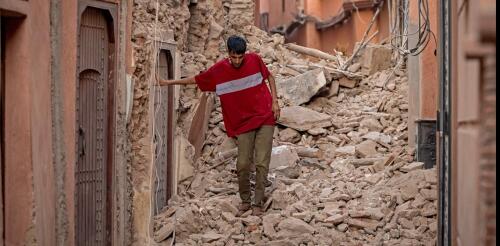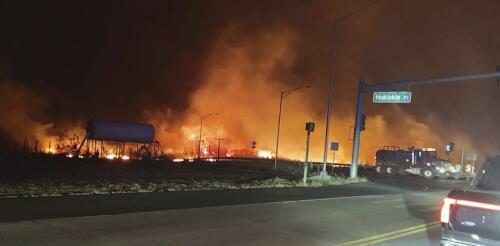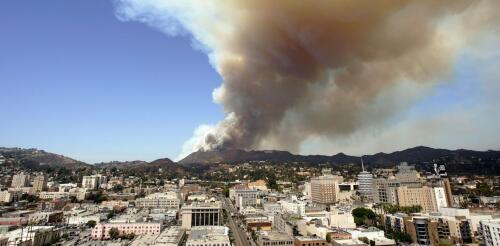Disaster
A wet winter and spring followed by a hot, dry summer can be a dangerous combination in the Western U.S. The rain fuels bountiful vegetation growth, and when summer heat dries out that vegetation, it can leave grasses and shrubs ready to burn. Drier than normal conditions, like many regions are experiencing in 2024, also raises the fire risk. In years like this, controlled burns and prescribed fire treatments are crucial to help protect communities against wildfires. Well-staffed fire crews ready to respond to blazes are essential, too. The National Oceanic and Atmospheric Administration Climate Prediction Center’s long-range seasonal forecast for summer 2024. NOAA However, on Feb. 8, U.S. Forest Service Chief Randy Moore told agency employees to expect budget cuts from Congress in 2024. His letter was thin on details. However, taken at face value, budget cuts could be interpreted as a reductio...
Strong winds blew across mountain slopes after a record-setting warm, dry summer. Small fires began to blow up into huge conflagrations. Towns in crisis scrambled to escape as fires bore down. This could describe any number of recent events, in places as disparate as Colorado, California, Canada and Hawaii. But this fire disaster happened over 110 years ago in the Northern Rocky Mountains of Idaho and Montana. The “Big Burn” of 1910 still holds the record for the largest fire season in the Northern Rockies. Hundreds of fires burned over 3 million acres – roughly the size of Connecticut – most in just two days. The fires destroyed towns, killed 86 people and galvanized public policies committed to putting out every fire. Many residents of Wallace, Idaho, fled on trains ahead of the 1910 blaze. Volunteers who stayed saved part of the town, but about a third of it burned. R.H. McKay/U.S. Forest Service...
Earthquakes, large and small, happen every single day along zones that wrap around the world like seams on a baseball. Most don’t bother anybody, so they don’t make the news. But every now and then a catastrophic earthquake hits people somewhere in the world with horrific destruction and immense suffering. On Oct. 7, 2023, a 6.3 magnitude earthquake struck near the historic city of Herat, Afghanistan, leaving more than 1,000 people dead in the rubble, according to estimates. It was followed by two more earthquakes, just as powerful, on Oct. 11 and Oct. 15. A few weeks earlier, on Sept. 8, a 6.8 magnitude earthquake shook ancient villages apart in the Atlas Mountains of Morocco, killing nearly 3,000 people. In February 2023, a large area of Turkey and Syria was devastated by two major earthquakes that hit in close succession. As a geologist, I study the forces that cause earthquakes. Here’s why some seismic zones are very active while others may be quiet for ge...
Wildfires, pushed by powerful winds, raced through Lahaina, Hawaii, on Aug. 8 and 9, 2023, leaving a charred and smoldering landscape across the tourist town of about 13,000 residents that was once the capital of the Kingdom of Hawaii. Nearly 100 people are believed to have died in the fires, Maui County officials said. Others were rescued by the U.S. Coast Guard after going into the ocean to escape the flames. Dry grasses and strong winds, influenced by Hurricane Dora passing far to the south, heightened the risk as wildfires burned both in Maui’s tourist-filled west coast and farther inland and on the Big Island of Hawaii. Most fires in the U.S. are suppressed before they have a chance to threaten communities, but the winds were too strong to send helicopters into the sky to help contain Maui’s fires on the first day, leaving firefighters to battle the blazes from the ground. Lt. Gov. Sylvia Luke issued an emergency declaration, activating the National Guard to he...
Over the past two decades, a staggering 21.8 million Americans found themselves living within 3 miles (5 kilometers) of a large wildfire. Most of those residents would have had to evacuate, and many would have been exposed to smoke and emotional trauma from the fire. Nearly 600,000 of them were directly exposed to the fire, with their homes inside the wildfire perimeter. Those statistics reflect how the number of people directly exposed to wildfires more than doubled from 2000 to 2019, my team’s new research shows. But while commentators often blame the rising risk on homebuilders pushing deeper into the wildland areas, we found that the population growth in these high-risk areas explained only a small part of the increase in the number of people who were exposed to wildfires. Instead, three-quarters of this trend was driven by intense fires growing out of control and encroaching on existing communities. A wildfire in 2017 dest...




